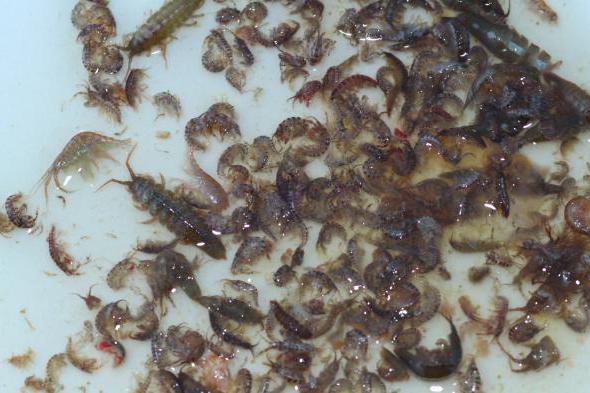Almost all the inhabitants of the aquariums had it. Someone was engaged in fish farming, another talked with a turtle, and the third is more like mysterious snails. Therefore, almost everyone knows that gammarus is food. But he was not born with food! So what is this creature while it is still alive?
Habitat
Gammarus is a crustacean living in almost every body of water in our country. Surprisingly, it easily adapts to life not only in fresh, but also in salt water. It has several names, such as booby, mormysh, hunchback, bormysh and even freshwater shrimp. In total there are more than 4.5 thousand species of this crustacean in the world, however, mainly two of them live in our reservoirs.
Gammarus is a bottom dweller. He lives under stones, climbs into holes in driftwood, hides among sand and pebbles near the coast, where there is a lot of detritus and plants. These crustaceans do not like bright light, preferring to stay in the shade. Able to withstand significant temperature fluctuations - from 0 to 26 degrees. If the reservoir in which the gammarus lives is completely frozen, the crustaceans burrow into the ground.
Gammarus is a crustacean whose life span is only about a year. In addition, they react rather painfully to water pollution, dying with insufficient oxygen.
Food
The crustacean eats rotting remains of fallen leaves and dead aquatic plants. Eating mainly plant food, gammarus will not refuse from the remains of fish or animals that died in the water. Sometimes crustaceans eat their smaller "brethren."
Appearance
Living, just like dry, gammarus has an arched body covered with shell. Chitin covers 14 segments. On the head are eyes and two pairs of antennae, which facilitate the search for food, as they are organs of touch. During movement, the crustacean moves sideways. He helps himself with 18 legs. Thanks to the method of movement, the crustacean has another name - amphipod.
On the breasts of the crustacean are gills. The abdominal and hind legs are equipped with bristles for swimming and taxiing. In addition, the rear ones help the crustacean to jump, and the abdominal ones help to keep food. The hind legs are constantly moving, providing an influx of water to the gills. Females, in addition, have a brood chamber for eggs located on the chest.
Breeding
Gammarus for turtles, like any other, constantly needs food, because it is constantly growing. Regularly there is a change in the chitinous membrane, which quickly becomes cramped to the growing body. About once a week in the summer and once every 16-17 days in the winter, molting occurs.
Crustaceans become sexually mature after replacing the chitin cover 10 times. They are able to bring posterity several times a year - it depends on the temperature of the water: in a warm body of water this happens much more often than in a cold one.
During spawning, the male clings to the shell of the female. Having caught, they can swim up to a week, waiting for the moment when the female begins to molt. Once this happens, the male helps to complete the process, after which he puts the seed on the walls of the egg bag using the abdominal legs. This process takes only a few seconds, after which it is detached. The female lays about 30 rather large eggs in a brood bag.
Embryos develop for 2-3 weeks, at the end of which fully formed crustaceans leave the bag.
Nutritional properties
Gammarus food is a valuable food source for fish of various species. It is used both in fish factories and for feeding aquarium fish and amphibians. Gammarus is used both as the main feed, and as a cleansing of the digestive system.
The main advantage of gammarus is its high nutritional value and significant carotene content. It should be borne in mind that living crustaceans are able to tolerate some parasites that can harm the health of fish. That is why you should use frozen, dried or ozonized food.
Artificial breeding
To feed fish at fish factories, as well as to feed the inhabitants of aquariums, it is not enough to catch crustaceans in various rivers. It is necessary to establish an uninterrupted supply of this type of feed. It is for this reason that special farms are created that supply feed for various types of aquarium fish and amphibians.
In order for the crustaceans to feel great, they dig out long ditches of about 30 cm in width and depth. Inside, small niches are made. As food, meat waste is used. It must be borne in mind that the meat must be fresh, in no case rotting. In the resulting ponds litter crustaceans, previously caught in natural reservoirs. Since crustaceans reproduce very quickly, a reservoir fills a nutrient gammarus in a rather short period of time. Fish food is selected very carefully, catching only individuals of a certain size. Thanks to this approach, you can feed fish with crustaceans of the size that suits them best. For example, young trout can eat only small amphipods, while adult individuals receive the largest.

When feeding aquarium fish with dry food, the size of the crustacean does not matter, since it is very easy to grind. However, large adult individuals are mainly removed from brood channels so that the livestock is constantly changing, and it remains possible to regularly receive fresh nutritious food for fish and turtles.
With the exhaustion of the resources of existing channels, new ones rummage, where young gammarus are transferred and the process starts from the very beginning.